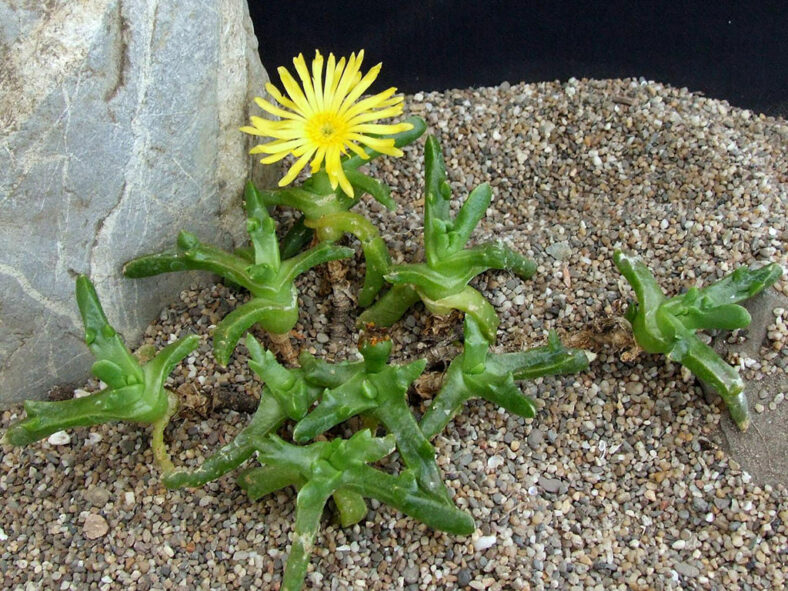Whether you have a garden, a rockery, or just a small pot, Glottiphyllum difforme is an excellent choice. It is easy to grow and maintain, making it an ideal option for those who want to enjoy its beauty without worrying much about its care.
Scientific Name
Glottiphyllum difforme (L.) N.E.Br.
Synonym(s)
Mesembryanthemum difforme
Scientific Classification
Family: Aizoaceae
Subfamily: Ruschioideae
Tribe: Ruschieae
Genus: Glottiphyllum
Etymology
The specific epithet "difforme" (pronounced dif-FOR-me) means "misshapen, deformed" and probably refers to the differences in leaf shapes, expression of teeth, width, and length of this species.
Origin
Glottiphyllum difforme is native to South Africa. It grows in shaly sandstone or on sandy to silty flats in karroid shrubland in the Steytlerville Karoo and the southeastern parts of the Great Karoo.
Description
Glottiphyllum difforme is a small succulent plant with fleshy, bright green leaves arranged in pairs along the branches. Each pair of leaves is at right angles to the pair above it or below it. The plant can grow up to 0.8 inches (20 cm) tall, forming a mat or occasionally an erect dwarf shrub. The leaves are smooth and have white margins, with two large teeth on their upper surface.
During the winter and spring, Glottiphyllum difforme produces solitary, short-stalked flowers with numerous narrow, yellow petals. The fruits are pale brown capsules with 6 to 8 locules and thick, spongy valves. Unlike some other species that drop the seed capsules early, this species retains them for more than a season.

How to Grow and Care for Glottiphyllum difforme
Light: Glottiphyllum difforme requires bright light but not too much direct sunlight. So, a windowsill that receives 4 to 5 hours of direct sunlight in the morning and partial shade in the afternoon will be a perfect spot for indoor growing.
Soil: The plant thrives in porous soil, allowing the water to drain away quickly. Therefore, use commercial soil for succulents or make your own well-draining mix.
Temperature: High temperatures are not a problem as long as there is plenty of fresh air, but this plant is not cold-hardy. It grows best in USDA Plant Hardiness Zones 9b to 11b, with average minimum winter temperatures ranging from 25°F to 50°F (- 3.9°C to 10°C).
Watering: To keep Glottiphyllum difforme healthy, it's essential to know when, how much, and how often to water. During the dormant period, usually in summer, the plant requires little or no water. In the fall, once it grows again, water thoroughly but allow the soil to dry between waterings.
Fertilizing: As long as you repot this plant every two years, it does not need fertilizer.
Repotting: Even if it can stay happy in the same pot for years, once in a while, you can repot your plant to give it more space anytime during the growing season. However, the best time is at the beginning of the growing season.
Propagation: Although it is usually started from seeds, Glottiphyllum difforme can also be easily propagated from stem cuttings during the growing season.
Learn more at How to Grow and Care for Mesembs.
Toxicity of Glottiphyllum difforme
Glottiphyllum difforme is considered non-toxic, so it is safe to have around kids and pets.
Links
- Back to genus Glottiphyllum
- Succupedia: Browse succulents by Scientific Name, Common Name, Genus, Family, USDA Hardiness Zone, Origin, or cacti by Genus
Photo Gallery
Click on a photo to see a larger version.


